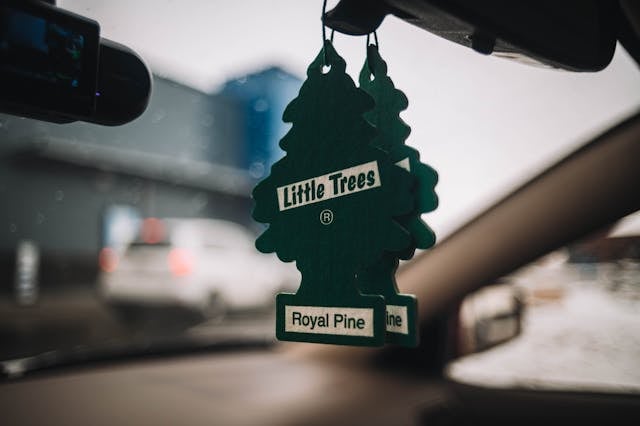From Pine Trees to Premium Scents: The Meteoric Rise of the Auto Air Freshener Industry

If you’ve ever clocked the unmistakable silhouette of a little pine tree swaying from a rearview mirror, you’ve seen the icon that effectively launched an industry. Little Trees, introduced in the early 1950s by perfumer Julius Samann, turned a simple insight into a global staple. It was simple, drivers wanted their cars to smell pleasant and for longer than a spritz of cologne could manage. That single die-cut card paved the way for a category that now spans vent clips, gel cans, essential-oil diffusers, smart dispensers, and bespoke luxury fragrances. Today’s auto air freshener business is bigger, more innovative, and more brand-savvy than ever, because the car itself has evolved from mere transportation into a highly personal space.
The First Wave: Scent as Utility
The earliest air fresheners were utilitarian. Little Trees’ genius wasn’t just scent, it was format. A lightweight, wallet-priced, disposable product that delivered consistent fragrance for weeks solved a specific problem. Lingering odors from smoke, pets, food, and damp upholstery. The distribution model matched the impulse nature of the purchase as gas stations, repair shops, convenience stores rushed to stock them next to the register. Margins were attractive, replenishment cycles were predictable, and brand recognition was off the charts thanks to that instantly recognizable tree shape and color palette.
As car ownership surged, so did time spent behind the wheel. Longer commutes, road trips, and the social status of the automobile expanded the addressable market. Early competitors followed with their own hanging cards and dashboard sticks, but the first wave was defined by parity products battling for pegboard real estate and retailer relationships. Category leadership was about availability, assortment breadth (from “New Car Scent” to “Vanillaroma”), and price discipline.
The Second Wave: Form Factor Innovation and FMCG Muscle
In the 1990s and 2000s, the category matured and diversified. Big household fragrance brands that were already experts in diffusion technology and scent development, brought fast-moving consumer goods (FMCG) sophistication to the aisle. Vent clips arrived, leveraging the HVAC airflow to increase throw and consistency. Gel cans and oil-based pods extended longevity and offered a “set-and-forget” user experience. Fragrance profiles became more complex, with layered notes and seasonal rotations echoing the cadence of candles and home air care.
This period also saw the rise of cross-channel branding. Household names parlayed trust and scent equity from kitchens and living rooms into cars, reassuring shoppers that a familiar brand would deliver predictable performance. Retailers responded by carving out dedicated shelf space, bundling car care with fragrance to capture higher volume shopping carts. Private label programs emerged, pressing national brands on price while using similar hardware formats licensed from OEM suppliers.
With innovation came competition for IP. Clip mechanisms, release membranes, and diffusion substrates became differentiators, as did packaging that promised “lasts up to X weeks.” The fight shifted from simple scent variety to perceived technology. Anti-odor claims, smoke-neutralizing additives, and heat-resistant gels. The category began to look less like a novelty and more like a science-backed subsegment of home and fabric care, just on wheels.
The Third Wave: Lifestyle, Premiumization, and Personalization
Over the last decade, the car cabin has become an extension of the home, especially as ride-sharing, delivery work, and long commutes drove more hours in vehicles. Consumers now curate their in-car environment with a level of personalization once reserved for our living rooms. That impulse unlocked premiumization.
Luxury-adjacent brands like Drift introduced unique housings, minimalist designs, and refillable cartridges with niche perfumery notes. Think fragrances like oud, amber, bergamot, and cedar rather than the old boring staples like cherry and orange. Automotive manufacturers dipped in with branded accessories that match interior trims. Specialized brands leaned into storytelling by focusing on natural ingredients, sustainably sourced bases, cruelty-free claims, and built subscription models that ship refills on cadence. The result became a barbell market where the iconic $3 hanging air freshener coexists with $30+ machined-aluminum diffusers and discovery sets.
Personalization is the new frontier. Some devices allow adjustable intensity or dual-scent blending. Others pair with the car’s vent geometry or use temperature-sensitive release to avoid overpowering. Custom air fresheners have taken off with companies like MakeMyFreshener and CustomAirFresheners.net leading the way for businesses, artists, and non-profits to slap their brand on an affordable promotional tool.
What’s Driving Demand
1) The economics of time-in-car. The more minutes people spend driving or being driven, the more they value a pleasant, consistent atmosphere. Gig workers and rideshare drivers treat scent as part of service quality and often claim it affects ratings and tips, making fragrance a business expense.
2) Resale value and cleanliness cues. A fresh-smelling cabin signals cleanliness and care, subtly supporting higher resale prices. Dealerships and detailers rely on fragrance as a finishing touch after reconditioning, reinforcing repeat purchases at service counters.
3) Wellness and mood management. As mental wellness went mainstream, consumers embraced aromatherapy-lite benefits. Calming lavender for traffic stress, citrus to feel energized, airy “linen” during summer. Whether or not the mood claims are clinically rigorous, they still resonate and sell.
4) Social media aesthetics. Cars are frequently staged for content on Instagram, Facebook, and TikTok. Interiors are visible in vlogs, “day-in-the-life” reels, and product hauls. Visually appealing hardware (sleek clips, sculptural diffusers) doubles as decor, pushing upgrades beyond simple function.
5) Giftability and subscription convenience. Low-ticket, high-satisfaction items make great add-ons and gifts. Subscriptions turn a sporadic aisle buy into recurring revenue with better demand predictability for brands.
Retail and Channel Shifts
Historically, auto parts stores, gas stations, and big box retailers were the backbone. They still matter, but direct to consumer and marketplaces have redrawn the map. Online channels support richer education (how different substrates diffuse, why certain notes last longer in heat), bundled upsells (cleaners, microfiber towels), custom air fresheners (for promotion or selling), and flexible packs (trial trios, seasonal rotations). For retailers, the opportunity lies in adjacent merchandising: placing air fresheners near car vacuums, wipes, and interior care drives attachment rates.
International expansion has accelerated as well. Scent preferences vary significantly by region, so localizing profiles is critical. Woody/resinous notes in some markets, tea and herbaceous blends in others, gourmand vanillas and fruits in yet others. The brands that win combine global operations with a hyperlocal nose.
Constraints That Spark Innovation
No consumer category grows without boundaries and auto fragrance has several that shape R&D:
-
Heat and volatility. Car interiors can exceed 120°F (49°C), challenging stability and diffusion control. Materials science (polymers, gels, wicks) continues to advance to maintain consistent release without leaks.
-
Regulatory compliance. Volatile organic compounds (VOCs), ingredient disclosure, and safety labeling vary by country and sometimes by state. California’s air quality standards and European regulations influence global formulations. Compliance raises barriers to entry and favors experienced players.
-
Safety and visibility. Anything dangling from a mirror risks obstructing the view, depending on local laws and driver height. That’s one reason vent-mounted and low-profile dashboard units have gained ground.
-
Sustainability expectations. Consumers increasingly seek recyclable housings, refill systems, and responsibly sourced aroma chemicals. Brands tout PCR plastics, aluminum chassis, and concentrated refills to reduce waste.
These constraints force better engineering, clearer communication, and distinctiveness beyond some fancy scent names.
What’s Next: Smart Scents and In-Cabin Ecosystems
Looking ahead, expect integration. Vehicles already have sensors for temperature, humidity, and cabin air quality. It’s not hard to imagine fragrance devices that modulate output based on sensor data or pair with infotainment systems to set “modes” (Focus, Calm, Road Trip). Automakers may bundle fragrance as part of an in-cabin wellness suite alongside ionizers, HEPA filtration, ambient lighting, and seat massage programs, with scent subscriptions available through their own app.
Sustainability will remain a strategic lever for climate concious consumers. Think recyclable cartridges, bio-based aroma chemicals, and closed-loop refill programs. And as EVs reduce engine noise, drivers pay more attention to the subtler aspects of cabin feel, making scent a surprisingly central element of perceived quality.
From Icon to Ecosystem
The auto air freshener market’s rise began with a clever, low-tech solution and grew into a sophisticated ecosystem at the intersection of chemistry, design, and lifestyle branding. Little Trees gave the category its first global symbol. The decades since have layered on rigor, luxury aspiration, and customization. What drives it is simple human behavior. People want their personal spaces, cars included, to smell good and feel good.








